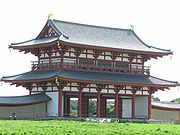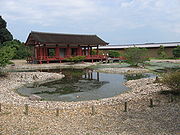
Heijo Palace
Encyclopedia


Nara, Nara
is the capital city of Nara Prefecture in the Kansai region of Japan. The city occupies the northern part of Nara Prefecture, directly bordering Kyoto Prefecture...
, was the Imperial Palace of Japan (710-784 AD), during most of the Nara period
Nara period
The of the history of Japan covers the years from AD 710 to 794. Empress Gemmei established the capital of Heijō-kyō . Except for 5 years , when the capital was briefly moved again, it remained the capital of Japanese civilization until Emperor Kammu established a new capital, Nagaoka-kyō, in 784...
. The Palace was located in the north end of the capital city, Heijō-kyō
Heijo-kyo
Heijō-kyō , was the capital city of Japan during most of the Nara period, from 710–40 and again from 745–84. The Palace site is a listed UNESCO World Heritage together with other places in the city of Nara Heijō-kyō (平城京, also Heizei-kyō, sometimes Nara no miyako), was the capital city of Japan...
. The remains of the palace, and the surrounding area, was established as a UNESCO
UNESCO
The United Nations Educational, Scientific and Cultural Organization is a specialized agency of the United Nations...
World Heritage Site
World Heritage Site
A UNESCO World Heritage Site is a place that is listed by the UNESCO as of special cultural or physical significance...
in 1998 along with a number of other buildings and area, as the "Historic Monuments of Ancient Nara
Historic Monuments of Ancient Nara
The UNESCO World Heritage Site Historic Monuments of Ancient Nara encompasses eight places in the old capital Nara in Nara Prefecture, Japan. Five are Buddhist temples, one is a Shinto shrine, one is a Palace and one a primeval forest. The properties include 26 buildings designated by the Japanese...
."
History
After Empress Genmei's succession to Imperial Throne in 707, there was much discussion about the transfer of the palace. A year later, a rescript was issued deciding on the move to Nara. In 710, the new capital officially takes over, but the completion of the palace had to wait further. (Written Heijō (平城) but also pronounced Nara at the time, the land gains its synonym, Nanto (南都, 'Southern Capital') as opposed to Kyoto, the capital in the North, centuries later.)The city, and the palace grounds, was based largely on Chang'an
Chang'an
Chang'an is an ancient capital of more than ten dynasties in Chinese history, today known as Xi'an. Chang'an literally means "Perpetual Peace" in Classical Chinese. During the short-lived Xin Dynasty, the city was renamed "Constant Peace" ; yet after its fall in AD 23, the old name was restored...
(present-day Xi'an
Xi'an
Xi'an is the capital of the Shaanxi province, and a sub-provincial city in the People's Republic of China. One of the oldest cities in China, with more than 3,100 years of history, the city was known as Chang'an before the Ming Dynasty...
), the capital of China
China
Chinese civilization may refer to:* China for more general discussion of the country.* Chinese culture* Greater China, the transnational community of ethnic Chinese.* History of China* Sinosphere, the area historically affected by Chinese culture...
during the Tang Dynasty
Tang Dynasty
The Tang Dynasty was an imperial dynasty of China preceded by the Sui Dynasty and followed by the Five Dynasties and Ten Kingdoms Period. It was founded by the Li family, who seized power during the decline and collapse of the Sui Empire...
, which was contemporary to the time when Nara was capital of Japan. Chang'an was in turn, like many ancient East Asian cities, based on a complex system of beliefs & laws of geomancy. This dictated the grid system of streets, as well as the necessity for spiritually protective shrines or temples to be placed at particular cardinal directions around the city.
In accordance with this system, the Palace was placed at the northern end, on an extended line from Suzaku Street, the main thoroughfare running north-south straight through the center of the city. The street ended at the Suzaku-mon
Suzakumon Gate
The was the main gate built in the center of the south end of the imperial palaces in the Japanese ancient capitals of Fujiwara-kyō , Heijō-kyō , and later Heian-kyō . The placement followed the ancient Chinese palace model requirements at the time, where , the Vermilion Bird was the Guardian of...
, depicted above, and the rest of the Palace buildings were then placed beyond to the north of this gate. The primary buildings of the Palace compound were the Daigoku-den, where governmental affairs were conducted, the Chōdō-in where formal ceremonies were held, the Dairi, the Emperor's residence, and offices for various administrative agencies. The foundations or footprints of these buildings are still visible on the site.
There was a former and a later palace.
When the capital was moved to Heian-kyō (now called Kyoto
Kyoto
is a city in the central part of the island of Honshū, Japan. It has a population close to 1.5 million. Formerly the imperial capital of Japan, it is now the capital of Kyoto Prefecture, as well as a major part of the Osaka-Kobe-Kyoto metropolitan area.-History:...
), Nara's Imperial Palace was simply abandoned. Over the ensuing centuries, the ravages of time and the elements slowly destroyed the buildings, until by the beginning of the Kamakura Period
Kamakura period
The is a period of Japanese history that marks the governance by the Kamakura Shogunate, officially established in 1192 in Kamakura by the first shogun Minamoto no Yoritomo....
in the late 12th century there was practically nothing left above ground. However, those sections that lay underground were preserved, and re-discovered by modern archaeologists.
While the site was designated Special Historical Site by the Agency for Cultural Affairs in 1952, archaeological efforts headed by the National Research Institute for Cultural Properties, such as excavations are continuing since 1959. The Suzaku-mon and Tou-in Garden have been restored and opened to the public in 1998.
Commemorative events of the 1300th anniversary
Heijō Palace is the Main Event Site of Commemorative events of the 1300th anniversary of Nara Heijō-kyō CapitalHeijo-kyo
Heijō-kyō , was the capital city of Japan during most of the Nara period, from 710–40 and again from 745–84. The Palace site is a listed UNESCO World Heritage together with other places in the city of Nara Heijō-kyō (平城京, also Heizei-kyō, sometimes Nara no miyako), was the capital city of Japan...
(Japanese:平城遷都1300年祭) in 2010, and the First Daigokuden(第一次大極殿) have been restored. In commemorative events of the 1300th anniversary, a variety of seasonal events will be held throughout Nara Prefecture from April 24 to November 7, 2010. The outline of Commemorative events of the 1300th anniversary in Heijō Palace is the following list.
- Main Event Site - Heijō-kyō Capital Area (Heijō Palace)
A:Entrance Plaza
●Heijō Palace Site Tour Center (探訪ツアーセンター)
●Corporate Participation Hall (出展参加ホール)
B:Heijō History Museum (平城宮跡資料館)
Full-Scale Replica of Japanese Diplomatic Ship for Envoys to Tang China (遣唐使船復原展示)
C:Suzaku Gate Plaza
●Suzaku Gate (Suzakumon, 朱雀門)
D:Exchange Plaza
●Mahoroba Stage (まほろばステージ)
●Exchange Hall (交流ホール)
E:Heijō Palace Site Museum (平城宮跡資料館)
F:Front Courtyard of the Former Imperial Audience Hall (the First Daigokuden, 第一次大極殿・前庭)
G:South Gate Plaza
●Tenpyo period costume rental area (天平衣装貸出所)
H:Heijō-kyō Hands-on Learning Plaza (体験学習広場)
●Heijō-kyō Hands-on Learning Center (平城京なりきり体験館)
●Ministry of the Imperial Household (宮内省)
I:Excavation Site Exhibition Hall (遺構展示館)
J:Eastern Palace Garden Plaza
●Eastern Palace Garden (Tōin Teien garden, 東院庭園)
Transport
It takes 15 or 20 minutes to walk from Yamato-Saidaiji StationYamato-Saidaiji Station
is a train station owned by Kintetsu Corporation and located in Saidaiji Kunimichō Itchōme, Nara, Japan. The station is also called or .-Lines:*Kintetsu**Nara Line**Kyoto Line**Kashihara Line...
to Heijō Palace. And between May and August in 2010, the free shuttle bus runs between Yamato-Saidaiji Station, JR Nara Station and Heijō Palace every 10 or 15 minutes.
See also
- Heijō-kyōHeijo-kyoHeijō-kyō , was the capital city of Japan during most of the Nara period, from 710–40 and again from 745–84. The Palace site is a listed UNESCO World Heritage together with other places in the city of Nara Heijō-kyō (平城京, also Heizei-kyō, sometimes Nara no miyako), was the capital city of Japan...
- Heian PalaceHeian PalaceThe Heian Palace was the original imperial palace of Heian-kyō , the capital of Japan, from 794 to 1227. In Japan, this palace is called Daidairi...
- Nara periodNara periodThe of the history of Japan covers the years from AD 710 to 794. Empress Gemmei established the capital of Heijō-kyō . Except for 5 years , when the capital was briefly moved again, it remained the capital of Japanese civilization until Emperor Kammu established a new capital, Nagaoka-kyō, in 784...
- Capital of JapanCapital of JapanThe capital of Japan, where the seat of the Government of Japan and home of the Emperor are located, is de facto. While this is generally not in dispute, the capital de jure is unclear. There is a dispute as to exactly when Tokyo became the capital. Some state that it occurred when Tokyo...
- List of Special Places of Scenic Beauty, Special Historic Sites and Special Natural Monuments
External links
- Official UNESCO page
- Geomancy and Imperial Position in Nara
- The Commemorative Events for the 1300th Anniversary (Available in Chinese, English, French, Korean and Japanese)

